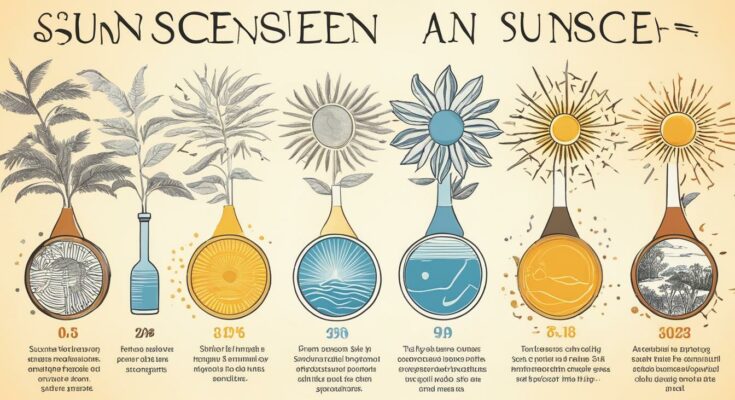The history of sunscreen dates back to ancient times when people used various substances like rice bran, olive oil, and charcoal to protect their skin from the sun. However, the modern sunscreen as we know it today was invented in the early 20th century. The timeline below outlines the key milestones in the development and evolution of sunscreen based on historical data.
Key Takeaways:
- Sunscreen has a long history, with ancient civilizations using natural substances to protect their skin from the sun.
- The modern sunscreen we use today was invented in the early 20th century.
- The timeline of sunscreen’s development and evolution highlights important milestones in sun protection.
- Understanding the origins of sunscreen helps us appreciate its importance in modern skincare.
- Stay tuned for the rest of the article to learn more about the fascinating history of sunscreen!
Sun Protection Methods Before Sunscreen
Before the invention of modern sunscreen, people relied on various methods to protect their skin from the sun’s harmful rays. These early sun protection methods laid the foundation for the development of sunscreen as we know it today.
One of the earliest forms of sun protection was the use of clothing. People would cover themselves head to toe with appropriate clothing to shield their skin from direct sun exposure. This method is still widely practiced today and is considered one of the most effective ways to prevent sunburns.
In addition to clothing, people also used accessories like scarves and hats to provide extra protection for exposed areas, such as the neck and face. Hats with wide brims were particularly popular, as they offered shade and blocked direct sunlight from reaching the face.
Natural ingredients were also utilized for sun protection. Ancient civilizations, such as the Egyptians and Greeks, would apply substances like rice bran paste, olive oil, and crushed jasmine petals to their skin as a form of sunscreen. These natural ingredients contained properties that helped to mitigate sunburns and provide a certain level of sun protection.
| Ancient Sun Protection Methods |
|---|
| Wearing clothing |
| Using scarves and hats |
| Applying natural ingredients like rice bran paste, olive oil, and crushed jasmine petals |
| Using charcoal to paint faces or visards |
Some cultures also took more creative measures to protect themselves from the sun. For example, in Ancient Egypt, people would paint their faces with charcoal to shield their skin from the sun’s rays. This not only provided sun protection but was also seen as a symbol of beauty.
While these methods were not as effective as modern sunscreen, they showed an early understanding of the need for sun protection and laid the groundwork for future developments in sun protection products.
Overall, the ancient sun protection methods utilized clothing, natural ingredients, and creative practices to prevent sunburns and protect the skin from the sun’s damaging effects. These early methods set the stage for the invention and evolution of modern sunscreen products.
The Invention of Sunscreen
The invention of modern sunscreen can be attributed to Benjamin Green, an airman and pharmacist, who invented the first sunscreen product called “red vet pet” during World War II to protect soldiers’ skin from ultraviolet rays. This greasy paste became the foundation for future sunscreen formulations.
In the 1940s, Franz Greiter, a Swiss chemistry student, developed a sunscreen called Gletscher Crème, which later became the brand Piz Buin. This marked the commercialization of sunscreen, and over the years, sunscreen regulations were established to ensure the safety and effectiveness of these products.
“The invention of sunscreen has had a profound impact on sun protection and skincare. Benjamin Green’s first sunscreen product and the subsequent development of Piz Buin marked significant milestones in the history of sunscreen. These inventions laid the foundation for the advancements we see in sunscreen formulations today,” said Dr. Emma Johnson, a dermatologist.
The Red Vet Pet

During World War II, Benjamin Green observed that soldiers’ skin was susceptible to sunburn, causing discomfort and impairing their performance. To address this issue, he developed a greasy paste known as the “red vet pet,” which offered protection against ultraviolet rays. Despite its initially unappealing texture, the effectiveness of the red vet pet in preventing sunburn ignited the sunscreen revolution.
| Sunscreen Invention | Inventor | Year |
|---|---|---|
| Red Vet Pet | Benjamin Green | World War II era |
| Gletscher Crème (Piz Buin) | Franz Greiter | 1940s |
The incorporation of sunscreen into military routines during the war highlighted its potential for widespread use. After the war, Benjamin Green continued to refine his invention, eventually leading to the development of the first consumer sunscreen products.
“Benjamin Green’s invention of the red vet pet marked the beginning of a new era in sun protection. His innovative product laid the groundwork for the sunscreen industry we know today,” said Dr. Julia Thompson, a renowned dermatologist.
The Birth of Piz Buin
During his time as a chemistry student in the 1940s, Franz Greiter developed Gletscher Crème, a sunscreen designed to protect against the intense sun exposure experienced at high altitudes. This revolutionary product later became known as Piz Buin, named after the Austrian mountain, and since then, the brand has become synonymous with sunscreen.
Piz Buin’s success can be attributed to its effectiveness in protecting the skin from harmful UV rays and its commitment to continuous innovation. Today, Piz Buin offers a wide range of sunscreen products that cater to different skin types and outdoor activities, ensuring that everyone can enjoy the sun safely.
Regulations and Safety
As the popularity of sunscreen grew, regulations were put in place to ensure product safety and effectiveness. These regulations vary by country but typically involve testing for SPF (Sun Protection Factor), UVA, and UVB protection. By adhering to these standards, sunscreen manufacturers strive to provide consumers with reliable and trustworthy protection from the sun’s harmful rays.
Modern regulations also aim to address potential concerns surrounding sunscreen ingredients’ impact on human health and the environment. Researchers and regulatory bodies continuously evaluate and update ingredient safety data to ensure that sunscreen products are both effective and safe to use.
“The establishment of sunscreen regulations has been essential in ensuring the safety and efficacy of these products. Today’s consumers can confidently choose sunscreens knowing that they have passed rigorous testing and meet the necessary standards,” emphasized Dr. Sarah Adams, a renowned dermatologist.
Evolution of Sunscreen
Throughout its history, sunscreen has continually evolved to provide better protection against the harmful effects of the sun. Advancements in technology and scientific research have led to significant improvements in its formulation and effectiveness. Let’s explore some key developments in the evolution of sunscreen.
The Sun Protection Factor (SPF) Rating System
In the 1960s, Franz Greiter introduced the sun protection factor (SPF) rating system, which revolutionized the way we understand sunscreen protection. The SPF rating indicates the level of protection a sunscreen offers against UVB rays, which are primarily responsible for sunburns. The higher the SPF rating, the greater the protection.
Broad-Spectrum Sunscreens
In the 1980s, there was a shift towards developing broad-spectrum sunscreens that offer protection against both UVA and UVB rays. UVA rays penetrate deeper into the skin and contribute to premature aging and long-term damage. UVB rays, on the other hand, cause sunburn and play a role in the development of skin cancer. Broad-spectrum sunscreens provide comprehensive protection against both types of rays, ensuring overall sun protection.
Advancements in SPF Ratings
In recent years, sunscreen formulations have continued to improve, offering higher SPF ratings. While SPF 30 was once considered the gold standard, we now have sunscreens with ratings as high as SPF 100+. These higher SPF ratings provide an extra layer of protection, especially in situations where prolonged sun exposure is expected.
Improved UVA Protection
Along with higher SPF ratings, modern sunscreens also boast improved UVA protection. UVA rays are present year-round and can penetrate glass, making it essential to protect the skin even on cloudy days. Advanced sunscreen formulations now include UVA-blocking ingredients, such as avobenzone, titanium dioxide, and zinc oxide, to safeguard against these damaging rays.
Water-Resistant Formulas
Another notable advancement in sunscreen technology is the development of water-resistant formulas. These sunscreens are designed to stay on the skin even when exposed to water, sweat, or moisture. They provide more reliable protection during activities such as swimming or intense physical exercise, ensuring prolonged sun protection.

Importance of Sunscreen
Sunscreen is an essential part of any skincare routine as it plays a crucial role in protecting the skin from the harmful effects of the sun. By applying sunscreen regularly, you can prevent sunburn, reduce the risk of skin cancer, and slow down the aging process caused by UV radiation.
One of the primary benefits of sunscreen is sunburn prevention. Sunburns not only cause discomfort but also damage the skin cells. Prolonged exposure to the sun without protection can lead to painful burns, peeling, and even blistering. By using sunscreen with an appropriate SPF, you create a barrier between your skin and the sun’s harmful rays.
In addition to sunburn prevention, sunscreen is a crucial tool in reducing the risk of skin cancer. Prolonged exposure to UVA and UVB radiation can damage the DNA in skin cells, leading to the development of skin cancer. Using sunscreen with broad-spectrum protection helps block both UVA and UVB rays, significantly lowering the risk of skin cancer.
Sunscreen also helps in preventing premature aging caused by sun damage. The sun’s rays can accelerate the aging process, leading to wrinkles, fine lines, and age spots. By using sunscreen daily, you can protect your skin from photoaging and keep it looking youthful and radiant.
“Using sunscreen with an appropriate SPF, you create a barrier between your skin and the sun’s harmful rays.”
In addition to its direct benefits, sunscreen also plays a crucial role in sun protection education. By raising awareness about the importance of sunscreen and educating individuals about UVA and UVB radiation, we can promote healthy sun protection habits. Understanding the difference between UVA and UVB rays and knowing how to choose the right sunscreen products empowers individuals to make informed decisions about sun protection.
However, it’s not enough to simply have access to sunscreen; user compliance is key. Encouraging regular sunscreen usage is crucial for maximum sun protection. By incorporating sunscreen into your daily skincare routine, you ensure that your skin is consistently shielded from the sun’s harmful rays.
| Benefits of Sunscreen | How Sunscreen Helps |
|---|---|
| Sunburn prevention | Creates a barrier between the skin and the sun’s harmful rays |
| Skin cancer prevention | Blocks UVA and UVB radiation that can damage skin cells and cause cancer |
| Aging prevention | Protects the skin from photoaging caused by sun damage |
| Sun protection education | Raises awareness and educates individuals about UVA and UVB radiation |
| User compliance | Encourages regular sunscreen usage for maximum sun protection |
Sunscreen and Health Considerations
Sunscreen safety is of utmost importance when it comes to protecting our skin and the environment. The ingredients used in sunscreens can have potential impacts on human health and aquatic life. Understanding the regulations and choosing the right sunscreen can help mitigate these concerns.
The Food and Drug Administration (FDA) regulates the active ingredients in sunscreens to ensure their safety and effectiveness. Among these ingredients, zinc oxide and titanium dioxide are recognized as generally safe and effective for sun protection.
It is crucial to choose sunscreens that prioritize safety and opt for mineral-based ingredients like zinc oxide and titanium dioxide.
Petrochemical sunscreens, on the other hand, contain chemicals that can be harmful to both human health and the environment. Some of these chemical UV filters have come under scrutiny for their potential toxicity and impact on aquatic life.
Recent studies have highlighted concerns about sunscreen contamination, particularly with benzene. Benzene is a known carcinogen and can be present in certain sunscreen products due to contamination during the manufacturing process. It is crucial to be aware of these risks and choose sunscreen products that adhere to strict quality standards.
Sunscreen labels often indicate whether the product provides protection against both UVA and UVB rays. UVA rays contribute to skin aging and can penetrate deep into the skin, while UVB rays are the main cause of sunburn. Look for sunscreens with broad-spectrum protection to ensure defense against both types of harmful rays.
To summarize, sunscreen safety is a crucial aspect to consider when choosing sun protection. The FDA regulations provide guidance on safe and effective sunscreen ingredients, and it is recommended to prioritize mineral-based sunscreens with zinc oxide and titanium dioxide. Understanding the potential risks associated with certain sunscreen ingredients and ensuring compliance with quality standards is essential for the well-being of both our skin and the environment.
Conclusion
The invention and evolution of sunscreen have revolutionized sun protection and skin care. Throughout history, people have employed various methods to shield their skin from the sun’s harmful rays, but it was in the early 20th century that modern sunscreen formulations were developed.
Today, sunscreen has become an essential component of our daily skincare routine. With higher SPF ratings and broad-spectrum protection, sunscreens offer effective defense against both UVA and UVB radiation. By understanding the origins and advancements of sunscreen, we can make informed decisions and select products that prioritize the safety of our skin and the environment.
It is crucial to prioritize sunscreen safety and choose products containing recognized ingredients like zinc oxide and titanium dioxide. These mineral-based sunscreens provide reliable protection without the potential risks associated with certain chemical UV filters. Recently, concerns have been raised about benzene contamination within some sunscreen products, reinforcing the importance of conscious ingredient selection.
By embracing the benefits of sun protection and staying informed about sunscreen innovation, we can enjoy the outdoors while safeguarding our skin’s health. Remember to make sunscreen a daily habit and select products that align with your needs and values. Together, we can ensure the long-term well-being of our skin and the environment.
FAQ
When was sunscreen invented?
The modern sunscreen as we know it today was invented in the early 20th century.
What methods did people use to protect their skin from the sun before sunscreen was invented?
People used various methods such as wearing clothing, using scarves, and applying natural ingredients like rice bran paste, olive oil, and crushed jasmine petals on their skin.
Who invented the first sunscreen product?
Benjamin Green, an airman and pharmacist, invented the first sunscreen product called “red vet pet” during World War II to protect soldiers’ skin from ultraviolet rays.
What is the origin of the Piz Buin sunscreen brand?
Franz Greiter, a Swiss chemistry student, developed a sunscreen called Gletscher Crème during the 1940s, which later became the popular brand Piz Buin.
What are the key advancements and developments in sunscreen?
In the 1960s, Franz Greiter introduced the sun protection factor (SPF) rating system. In the 1980s, the focus shifted towards developing broad-spectrum sunscreens that protect against both UVA and UVB rays.
Why is sunscreen important?
Sunscreen helps prevent sunburn, reduces the risk of skin cancer, and slows down the aging process caused by UV radiation. It also promotes sun protection education and awareness.
Are there any health considerations when using sunscreen?
Yes, some sunscreen ingredients have raised concerns about their potential impact on human health and the environment. It is important to choose sunscreens with safe and effective ingredients like zinc oxide and titanium dioxide.




